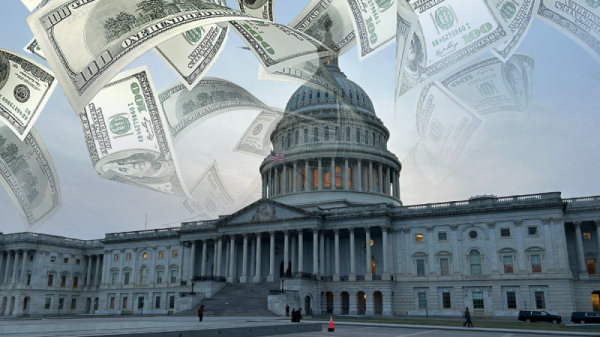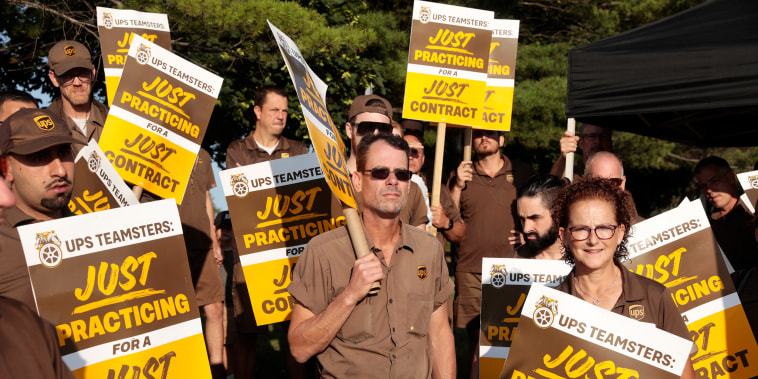Negotiators for UPS and the Teamsters union representing some 340,000 workers at the nation’s largest package carrier are going back to the table on Tuesday, seeking to finalize a labor deal by the end of the month.
If the parties fail to reach a tentative contract agreement in time, UPS workers have committed to walking off the job at 12:01 a.m. ET on Aug. 1, risking widespread disruptions to deliveries across the country.
Here’s a look at the current state of the standoff and what to expect in the days ahead.
How close are the two sides to reaching a deal?
Most of the elements for a new five-year contract are already in place, negotiators have said.
UPS agreed last month to a range of new heat-safety protections, including bringing air conditioning to its iconic brown delivery fleet for the first time. The Teamsters hailed those changes as a major breakthrough after years of complaints that working in hot weather has grown more dangerous, with climate change fueling record-breaking summer heat waves across the country.
UPS workers and Teamsters members practice picket outside a UPS distribution facility in Madison Heights, Mich., on July 18, 2023. Jeff Kowalsky / Bloomberg via Getty Images
“Ninety-five percent of the contract, noneconomic issues, are done,” Teamsters president Sean O’Brien told MSNBC on Sunday.
Some important economic matters have already been resolved as well. The Teamsters announced in early July that they’d secured an end to an unpopular two-tiered workforce system long criticized as shortchanging weekend drivers, in addition to curtailing forced overtime on scheduled days off.
Which issues are still unresolved?
Pay for part-time UPS workers has been one of the key remaining sticking points. Last Thursday, as the two sides announced they were resuming talks, UPS said it was “prepared to increase our industry-leading pay and benefits.”
Part-time unionized workers already make an average of $20 an hour and get “the exact same industry-leading health and medical benefits as full-time employees,” the company said in a statement earlier this month, adding that “they are among just 7% of U.S. private sector employees to receive a pension.”
The rise of e-commerce, accelerated by the pandemic, has reshaped UPS workers’ demands since 2018, when their last collective bargaining agreement was approved. They’re now sorting and delivering millions more packages — 6.2 billion globally in 2022, up from 5.5 billion in 2019. Teamsters leaders have argued that UPS should use the $13 billion it generated in profits last year to improve pay and working conditions.
What happens if there’s no deal by Aug. 1?
If a deal can’t be reached in time, UPS workers have vowed to walk off the job, in what would be the largest single-employer strike in U.S. history. While any tentative pact would still need to be ratified through a vote by rank-and-file workers to take effect, a handshake agreement would likely forestall a strike.
Some labor experts say that the union has the ability to extend its existing contract beyond its July 31 expiration date at its own discretion. Doing so could create more time for voting if a deal is struck in the final days of July or even afterward.
But the union has appeared to dismiss that possibility, consistently emphasizing its Aug. 1 deadline. A Teamsters spokesperson told NBC News earlier this month, “The previous Teamsters administration gave extensions and concessions, but those days are over and UPS needs to face this reality.”
What would be the impact of a strike?
The Anderson Economic Group recently forecast that a 10-day walkout would cost the U.S. economy some $7 billion, with workers racking up $1.1 billion in lost wages and UPS seeing $816 million in losses.
While much would depend on how long it lasts, a UPS strike would almost certainly be less costly and disruptive than the threatened freight rail strike that was averted last September after the Biden administration brokered a labor pact. A railroad industry group had estimated at the time that a work stoppage on the nation’s freight rail network would cost the economy as much as $2 billion a day. The Teamsters have urged the White House not to intervene in its current standoff.
Logistics experts warn that even a few days of halted UPS deliveries would trigger widespread disruptions. A walkout would likely delay the flow of more packages than top rivals such as FedEx or the U.S. Postal Service could absorb, threatening to upend the back-to-school shopping season. For its part, UPS said on July 14 that it was in the process of training nonunion drivers to help pick up the slack in case of a Teamsters walkout.
The carrier handles about a quarter of U.S. parcel shipments. Worldwide, UPS estimates it delivers more than 24.3 million packages a day, shuttling items from some 1.6 million shipping customers to more than 11.1 million recipients. The company estimates that 85% of Americans live within 10 miles of a UPS store.
Major retailers have had a long time to prepare for a strike, with backup plans months in the making, industry experts say. Many companies diversified their delivery providers during the pandemic, adding smaller, more regional carriers. But smaller businesses, particularly those in rural areas, have few alternatives to UPS. In recent weeks, some have simply been watching the stop-and-start labor talks and hoping for the best.
The last UPS strike, involving some 185,000 workers in 1997, lasted 15 days and cost UPS at least $600 million. The union centered its demands on securing better wages and job security and resulted in employee gains on both fronts.


































